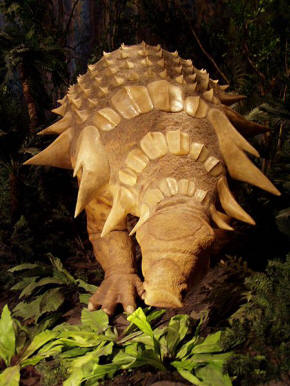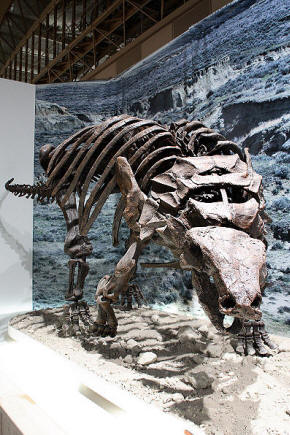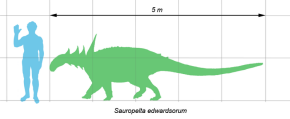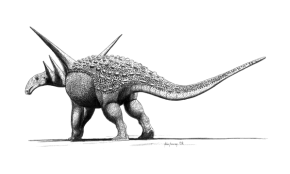|
Edmontonia
Edmontonia was an
armoured dinosaur,
a part of the
nodosaur family from the Late Cretaceous Period (76.5 to 65.5
Ma). It is named after the Edmonton Formation (now the
Horseshoe Canyon Formation), the unit of rock it was found in.
Edmontonia was bulky and
tank-like at
roughly 6.6 m (22 ft) long and 2 m (6 ft) high. It had small, ridged bony
plates on its back and head and many sharp spikes along its back and tail.
The four largest spikes jutted out from the shoulders on each side, two of
which were split into subspines in some specimens. Its skull had a
pear-like shape
when viewed from above. (Compare 26 feet long and 8 feet high for the
M1 Abrams
army tank.)
The large spikes were probably used between males in contests of strength
to defend territory or gain mates. The spikes would also have been useful
for intimidating predators or rival males, protection, or for self-defense.
To protect itself from predators, an Edmontonia might have crouched
down on the ground to minimize the possibility of attack to its defenseless
underbelly.
Rings in the petrified wood of trees contemporary with
Edmontonia
show evidence of strong seasonal changes in precipitation and temperature;
this may hold an explanation for why so many specimens have been found with
their armor plating and spikes in the same position they were in life. The
Edmontonia could have died due to drought, dried up, and then rapidly
became covered in sediment when the rainy season began.
Sauropelta
Sauropelta (meaning 'lizard shield') is a
genus of
nodosaurid
dinosaur
that existed in the Early
Cretaceous Period of
North America. One
species (S.
edwardsorum) has been named although others may have existed.
Anatomically, Sauropelta is one of the most well-understood
nodosaurids, with
fossilized
remains recovered in the
U.S. states of
Wyoming,
Montana,
and possibly Utah.
It is also the earliest known genus of nodosaurid; most of its remains are
found in the
Cloverly Formation, which dates to about 115 to 110
Ma (million
years ago).
It was a medium-sized nodosaurid, measuring about 5 meters (16.5 ft)
long. Sauropelta
had a distinctively long tail which made up about
half of its body length. Although its body was smaller than a modern
black rhinoceros,
Sauropelta was about the same mass, weighing in
at about 1,500
kilograms (3,300
lb).
The extra weight was largely due to its extensive bony
body armor, including the characteristically large spines projecting
from its neck.
Sauropelta was a heavily-built
quadrupedal
herbivore
with a body length of approximately
5 meters (16.5 ft).
The skull was
triangular when viewed from above, with the rear end wider than the tapering
snout.
Unlike some other nodosaurids, the roof of the skull was characteristically
flat, not domed. The tail of
Sauropelta was characteristically long and made up
nearly half of the body length. One skeleton preserved forty caudal (tail)
vertebrae, although some were missing, suggesting that the true number
of caudal vertebrae may have exceeded fifty.
Ossified
tendons stiffened the tail along its length. Like other ankylosaurs,
Sauropelta had a wide body, with a very broad pelvis and ribcage. The
forelimbs were shorter than the hindlimbs, which resulted in an arched back,
with the highest point over the hips. Its
feet, limbs,
shoulders,
and pelvis
were all very stoutly constructed and reinforced to support a great deal of
weight.
Discovery and naming
In the early 1930s, famed dinosaur hunter and paleontologist
Barnum Brown collected the
holotype
specimen of Sauropelta (AMNH 3032, a partial skeleton) from the
Cloverly Formation in
Big Horn County, Montana. The locality is inside the
Crow Indian Reservation. Brown also discovered two other specimens (AMNH
3035 and 3036). The latter is one of the best-preserved nodosaurid skeletons
known to science, includes a large amount of in situ armor, and is on
display in the
American Museum of Natural History in
New York City. Expeditions in the 1960s led by
the equally renowned
John
Ostrom of
Yale University's
Peabody Museum of Natural History recovered additional incomplete
specimens from the Cloverly. In 1970, Ostrom coined the genus
Sauropelta
to include remains discovered by both expeditions. Derived from the
Greek
σαυρος/sauros ('lizard') and
πελτε/pelte
('shield'), this name is a reference to its bony armor.
Although Ostrom originally named the species S. edwardsi,
nomenclaturist
George Olshevsky corrected the spelling to
S. edwardsorum in 1991
to conform to Latin
grammar rules.
Paleoecology
Sauropelta is the earliest known nodosaurid genus. All specimens
of S. edwardsorum were recovered from the middle section of the
Cloverly Formation in Wyoming and Montana, which dates to the late
Aptian
through early
Albian
stages of the
Early Cretaceous, or about 115 to 110 Ma (million years ago).
Sauropelta lived in wide floodplains around
rivers that
drained into the shallow inland sea to the north and east, carrying sediment
eroded from the low mountains to the west. Periodic flooding of these rivers
covered the surrounding plains with new muddy sediments, creating the
Cloverly Formation and burying the remains of many animals, some of which
would be fossilized. At the end of Cloverly times, the shallow sea would
expand to cover the entire region and would eventually split North America
completely in half, forming the
Western Interior Seaway.
Abundant fossil remains of
coniferous
trees suggest that these plains were covered in
forests.
Grasses
would not evolve until later in the Cretaceous, so
Sauropelta and
other Early Cretaceous dinosaurian herbivores browsed from a variety of
conifers and
cycads.
Nodosaurids like Sauropelta had narrow snouts, an adaptation seen
today in animals that are selective browsers as opposed to the wide muzzles
of grazers.
Return to the
Old Earth Ministries Online Dinosaur
Curriculum homepage.

|



